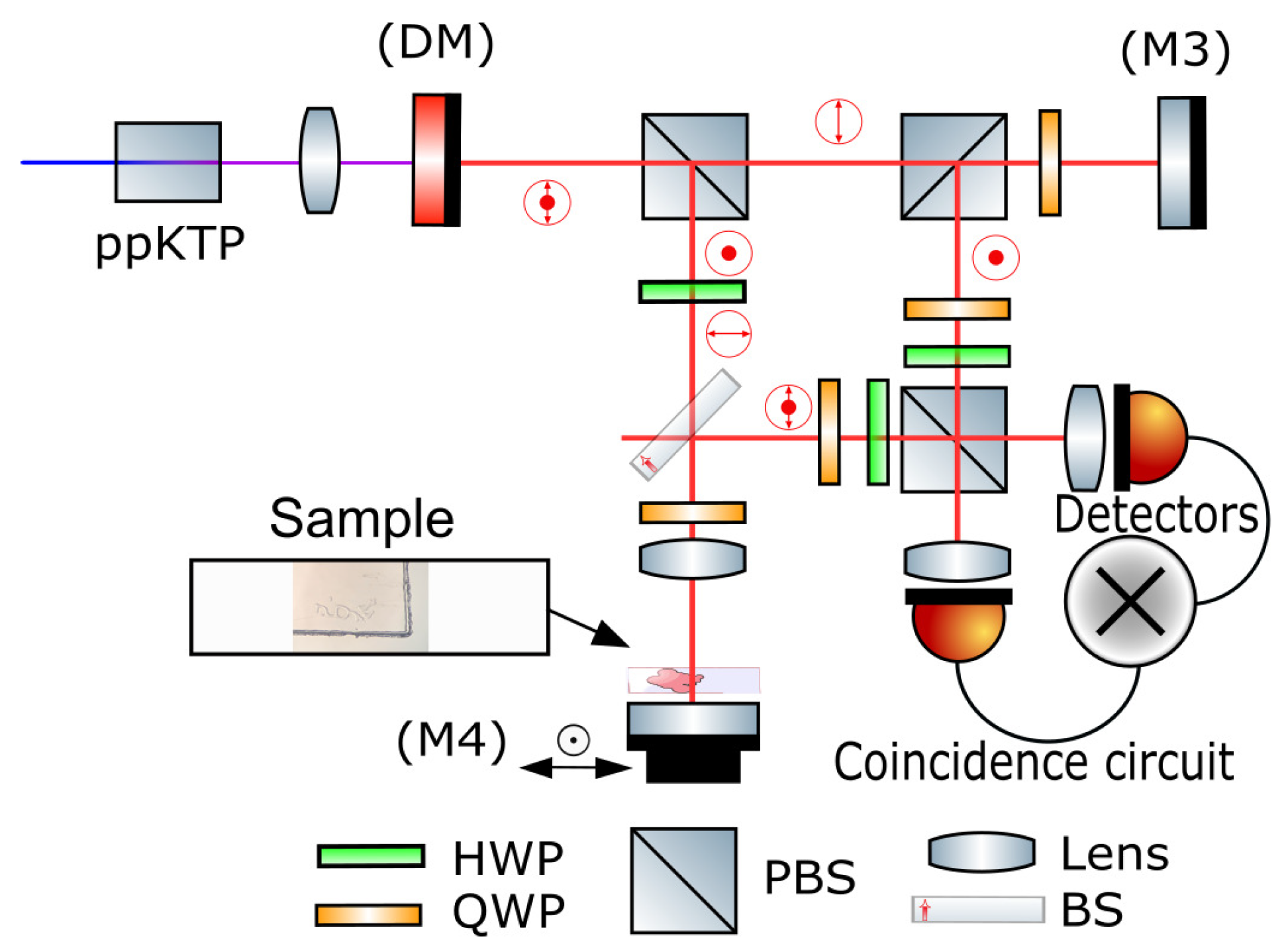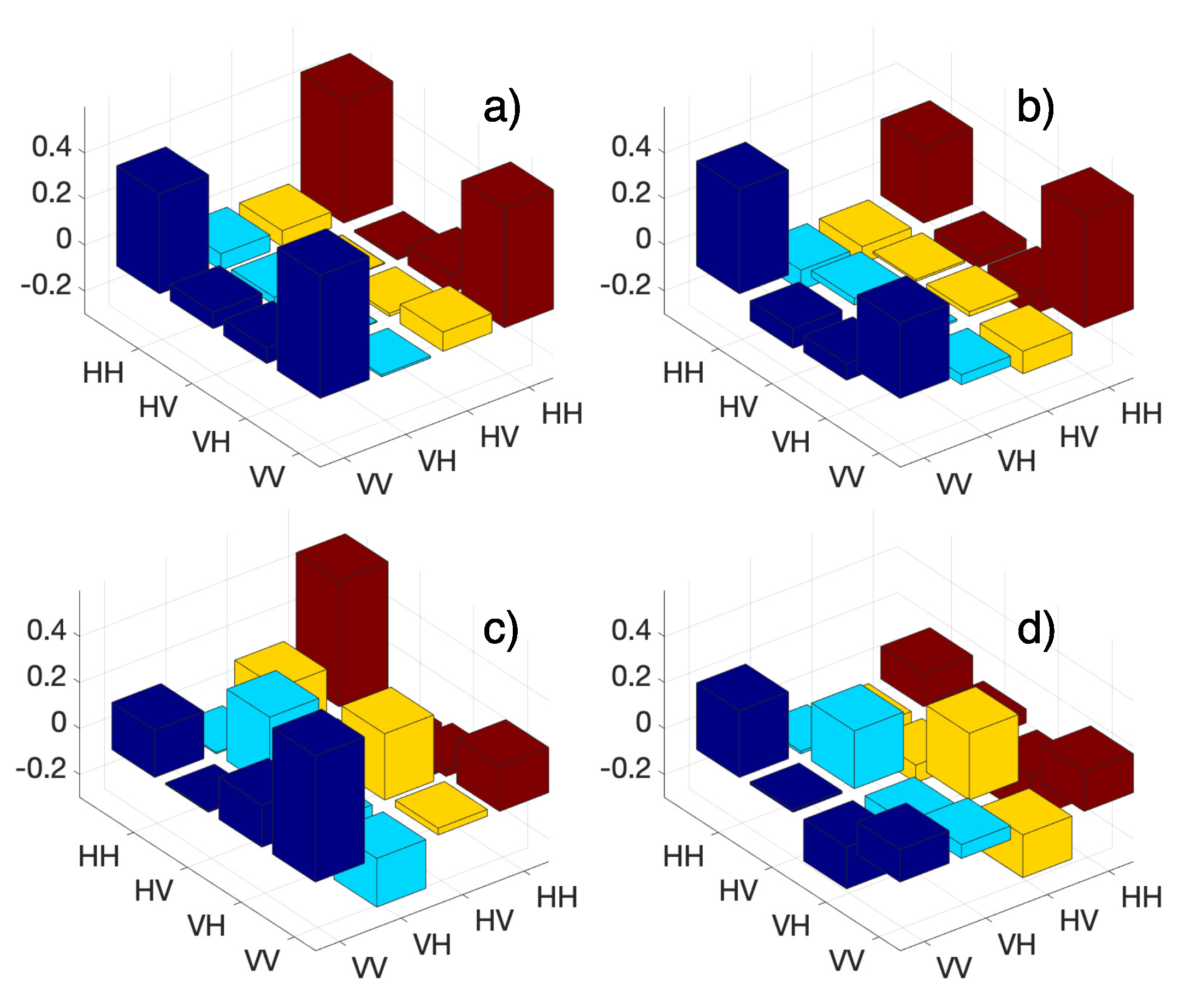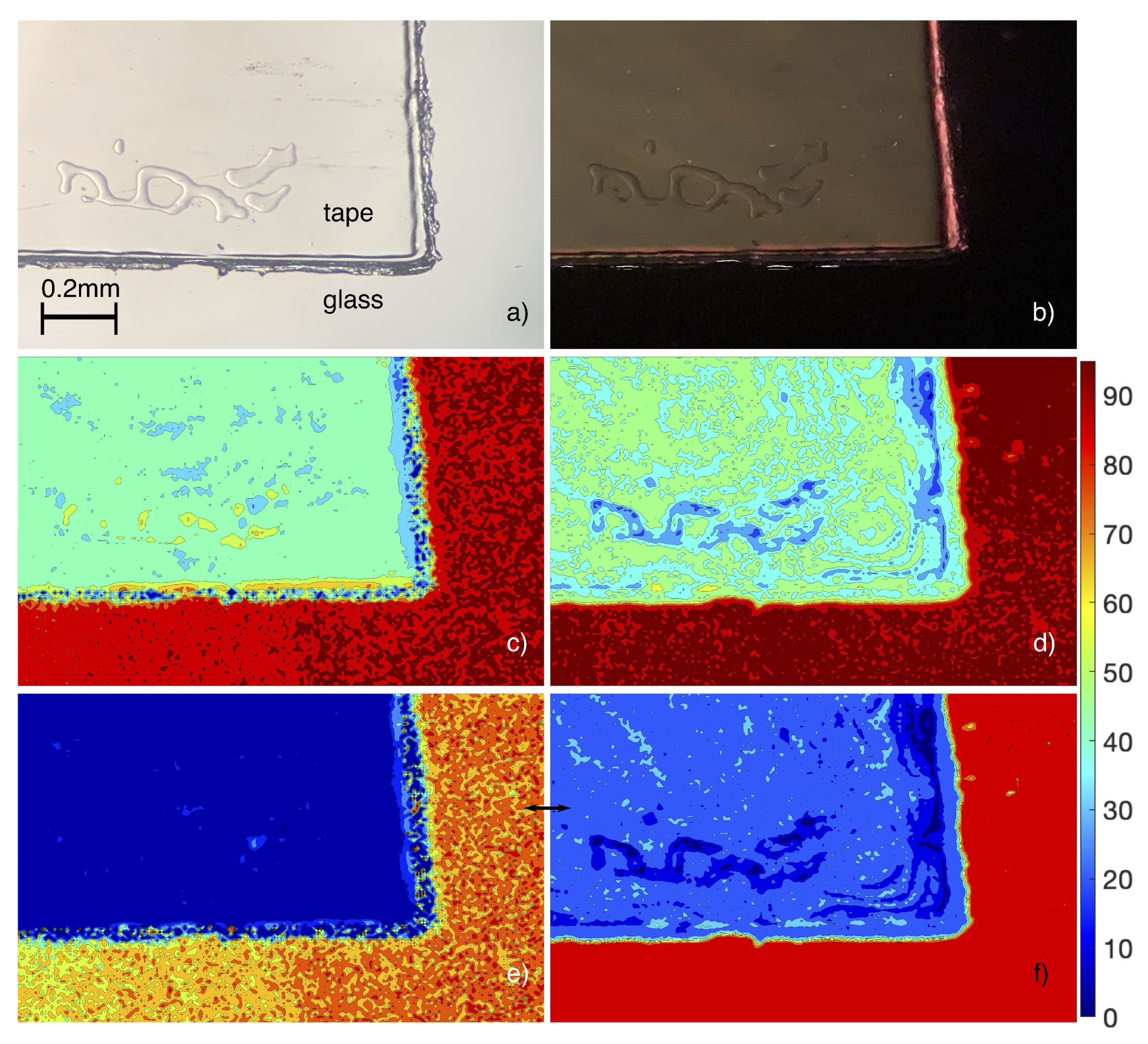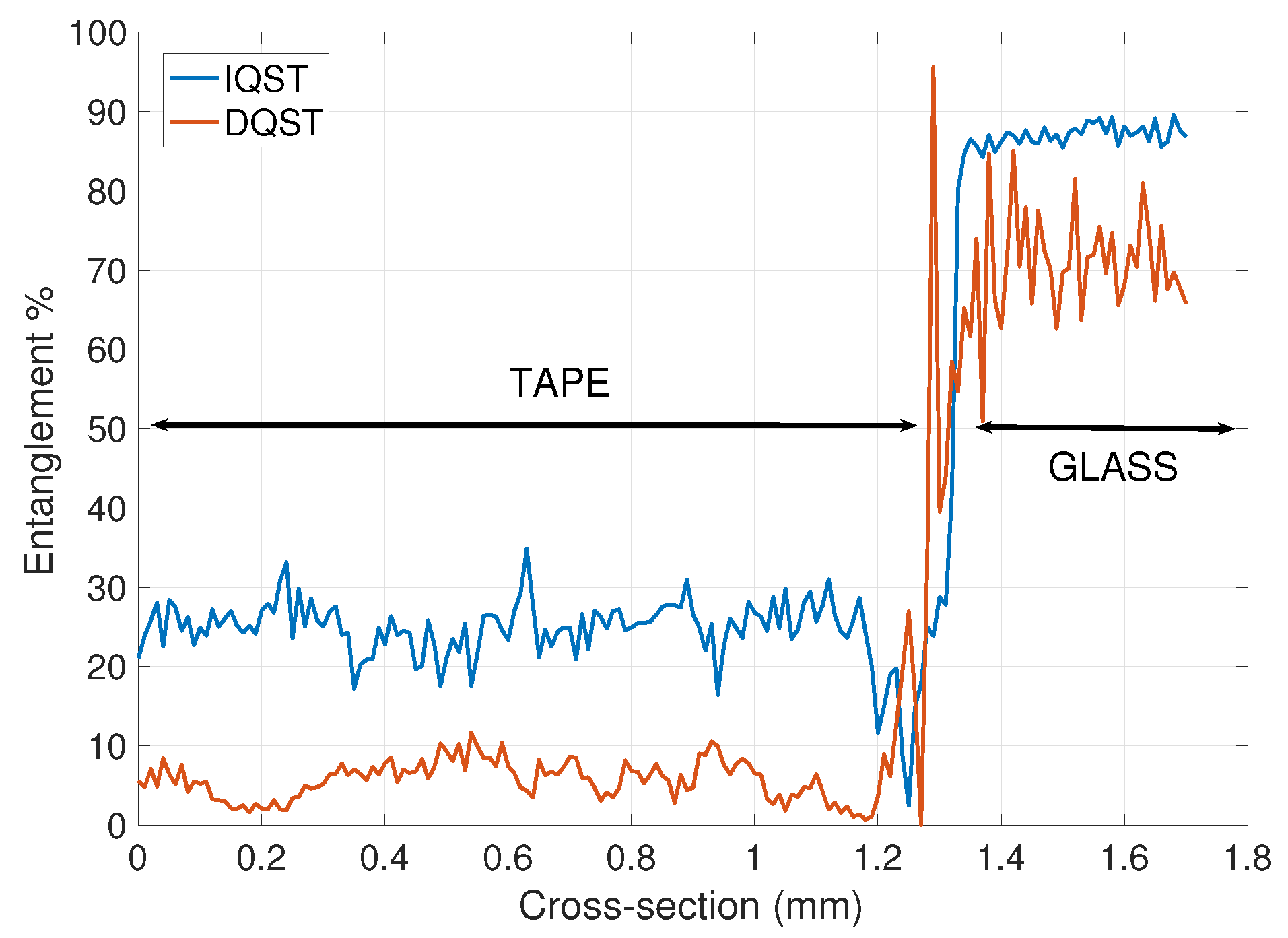Polarization Sensitive Imaging with Qubits
Abstract
:1. Introduction
2. Materials and Methods
2.1. Direct Quantum State Tomography (DQST) Overview
2.2. Inverse Numerical Optimization of Quantum State Tomography (IQST) Overview
2.3. Entanglement Computation
2.4. Experimental Setup
3. Results
4. Discussion
Author Contributions
Funding
Institutional Review Board Statement
Informed Consent Statement
Data Availability Statement
Conflicts of Interest
References
- Defienne, H.; Ndagano, B.; Lyons, A.; Faccio, D. Polarization entanglement-enabled quantum holography. Nat. Phys. 2021, 17, 591. [Google Scholar] [CrossRef]
- Devaux, F.; Mosset, A.; Bassignot, F.; Lantz, E. Quantum holography with biphotons of high Schmidt number. Phys. Rev. A 2019, 99, 033854. [Google Scholar] [CrossRef] [Green Version]
- Häffner, H.; Hänsel, W.; Roos, C.F.; Benhelm, J.; Chek-al-kar, D.; Chwalla, M.; Körber, T.; Rapol, U.D.; Riebe, M.; Schmidt, C.; et al. Scalable multiparticle entanglement of trapped ions. Nature 2005, 438, 643–646. [Google Scholar] [CrossRef] [Green Version]
- James, D.F.V.; Kwiat, P.G.; Munro, W.J.; White, A.G. Measurement of qubits. Phys. Rev. A 2001, 64, 052312. [Google Scholar] [CrossRef] [Green Version]
- Shi, L.; Galvez, E.; Alfano, R. Photon Entanglement Through Brain Tissue. Sci. Rep. 2016, 6, 37714. [Google Scholar] [CrossRef] [Green Version]
- Jack, B.; Leach, J.; Ritsch, H.; Barnett, S.M.; Padgett, M.J.; Franke-Arnold, S. Precise quantum tomography of photon pairs with entangled orbital angular momentum. New J. Phys. 2009, 11, 103024. [Google Scholar] [CrossRef]
- Altepeter, J.B.; Branning, D.; Jeffrey, E.; Wei, T.C.; Kwiat, P.G.; Thew, R.T.; O’Brien, J.L.; Nielsen, M.A.; White, A.G. Ancilla-Assisted Quantum Process Tomography. Phys. Rev. Lett. 2003, 90, 193601. [Google Scholar] [CrossRef] [Green Version]
- Israel, Y.; Afek, I.; Rosen, S.; Ambar, O.; Silberberg, Y. Experimental tomography of NOON states with large photon numbers. Phys. Rev. A 2012, 85, 022115. [Google Scholar] [CrossRef] [Green Version]
- Neugebauer, M.; Fischer, L.; Jager, A.; Czischek, S.; Jochim, S.; Weidemuller, M.; Garttne, M. Neural-network quantum state tomography in a two-qubit experiment. Phys. Rev. A 2020, 102, 042604. [Google Scholar] [CrossRef]
- Mihailov, A.E.; Latypov, I.Z.; Kalinkin, A.A.; Shkalikov, A.V.; Kalachev, A.A.; Samartsev, V.V. Polarization tomography of a narrow-band biphoton field. Bull. Russ. Acad. Sci. Phys. 2011, 75, 1658–1663. [Google Scholar] [CrossRef]
- Pilnyak, Y.; Zilber, P.; Cohen, L.; Eisenberg, H.S. Quantum tomography of photon states encoded in polarization and picosecond time bins. Phys. Rev. A 2019, 100, 043826. [Google Scholar] [CrossRef] [Green Version]
- Bayraktar, O.; Swillo, M.; Canalias, C.; Bjork, G. Quantum-polarization state tomography. Phys. Rev. A 2016, 94, 020105. [Google Scholar] [CrossRef] [Green Version]
- Erhard, M.; Qassim, H.; Mand, H.; Karimi, E.; Boyd, R.W. Real-time imaging of spin-to-orbital angular momentum hybrid remote state preparation. Phys. Rev. A 2015, 92, 022321. [Google Scholar] [CrossRef] [Green Version]
- Agnew, M.; Leach, J.; McLaren, M.; Roux, F.S.; Boyd, R.W. Tomography of the quantum state of photons entangled in high dimensions. Phys. Rev. A 2011, 84, 062101. [Google Scholar] [CrossRef] [Green Version]
- Gross, D.; Liu, Y.-K.; Flammia, S.T.; Becker, S.; Eisert, J. Quantum state tomography via compressed sensing. Phys. Rev. Lett. 2010, 15, 105. [Google Scholar] [CrossRef] [Green Version]
- Hradil, Z. Quantum state estimation. Phys. Rev. A 1997, 55, 1561. [Google Scholar] [CrossRef] [Green Version]
- Straupe, S.S. Adaptive quantum tomography. JETP Lett. 2016, 7, 510–522. [Google Scholar] [CrossRef]
- Řeháček, J.; Hradil, Z.; Knill, E.; Lvovsky, A.I. Diluted maximum-likelihood algorithm for quantum tomography. Phys. Rev. A 2007, 75, 042108. [Google Scholar] [CrossRef] [Green Version]
- Miranowicz, A.; Bartkiewicz, K.; Perina, J., Jr.; Koashi, M.; Imoto, N.; Nori, F. Optimal two-qubit tomography based on local and global measurements: Maximal robustness against errors as described by condition numbers. Phys. Rev. A 2014, 90, 062123. [Google Scholar] [CrossRef] [Green Version]
- Lee, S.M.; Kim, H.; Cha, M.; Moon, H.S. Polarization-entangled photon-pair source obtained via type-II non-collinear SPDC process with PPKTP crystal. Opt. Express 2016, 24, 2941–2953. [Google Scholar] [CrossRef] [Green Version]
- Jeong, Y.-C.; Hong, K.-H.; Kim, Y.-H. Bright source of polarization-entangled photons using a PPKTP pumped by a broadband multi-mode diode laser. Opt. Express 2016, 24, 1165–1174. [Google Scholar] [CrossRef] [PubMed]
- Lopez-Mago, D.; Novotny, L. Quantum-Optical Coherence Tomography with Collinear Entangled Photons. Opt. Lett. 2012, 37, 4077–4079. [Google Scholar] [CrossRef]
- Schwemmer, C.; Knips, L.; Richart, D.; Weinfurter, H.; Moroder, T.; Kleinmann, M.; Guhne, O. Systematic Errors in Current Quantum State Tomography Tools. Phys. Rev. Lett. 2015, 114, 080403. [Google Scholar] [CrossRef] [PubMed] [Green Version]
- Hariri, L.P.; Villiger, M.; Applegate, M.B.; Mino-Kenudson, M.; Mark, E.J.; Bouma, B.E.; Suter, M.J. Seeing beyond the bronchoscope to increase the diagnostic yield of bronchoscopic biopsy. Am. J. Respir. Crit. Care Med. 2013, 187, 125–129. [Google Scholar] [CrossRef] [PubMed] [Green Version]
- Carriel, V.S.; Aneiros-Fernandez, J.; Arias-Santiago, S.; Garzón, I.J.; Alaminos, M.; Campos, A. A novel histochemical method for a simultaneous staining of melanin and collagen fibers. J. Histochem. Cytochem. 2011, 3, 59. [Google Scholar]
- Patel, R.; Khan, A.; Quinlan, R.; Yaroslavsky, A.N. Polarization-Sensitive Multimodal Imaging for Detecting Breast Cancer. Cancer Res. 2014, 74, 4685–4693. [Google Scholar] [CrossRef] [PubMed] [Green Version]




Publisher’s Note: MDPI stays neutral with regard to jurisdictional claims in published maps and institutional affiliations. |
© 2022 by the authors. Licensee MDPI, Basel, Switzerland. This article is an open access article distributed under the terms and conditions of the Creative Commons Attribution (CC BY) license (https://creativecommons.org/licenses/by/4.0/).
Share and Cite
Sukharenko, V.; Dorsinville, R. Polarization Sensitive Imaging with Qubits. Appl. Sci. 2022, 12, 2027. https://doi.org/10.3390/app12042027
Sukharenko V, Dorsinville R. Polarization Sensitive Imaging with Qubits. Applied Sciences. 2022; 12(4):2027. https://doi.org/10.3390/app12042027
Chicago/Turabian StyleSukharenko, Vitaly, and Roger Dorsinville. 2022. "Polarization Sensitive Imaging with Qubits" Applied Sciences 12, no. 4: 2027. https://doi.org/10.3390/app12042027
APA StyleSukharenko, V., & Dorsinville, R. (2022). Polarization Sensitive Imaging with Qubits. Applied Sciences, 12(4), 2027. https://doi.org/10.3390/app12042027





